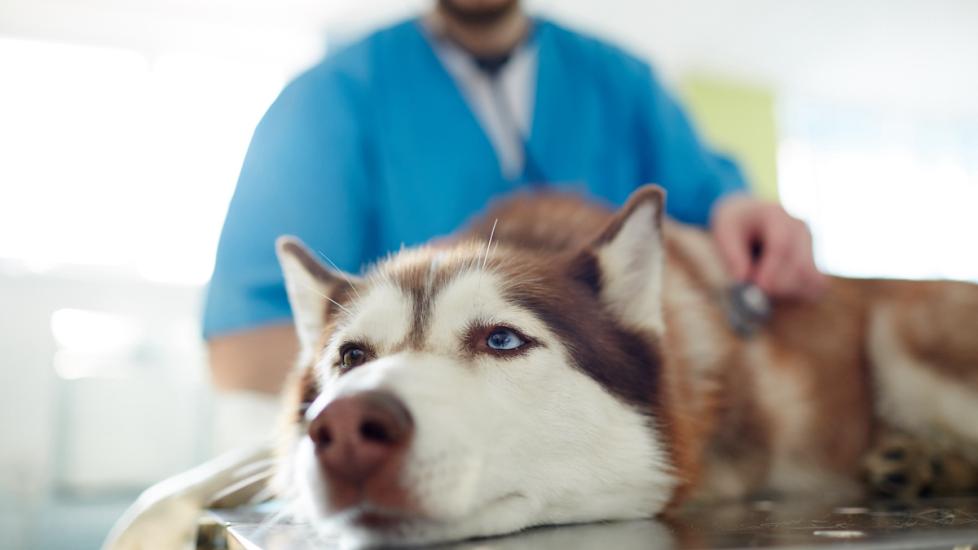Syringomyelia (SM) and Chiari Malformation (CM) in Dogs
What Are Syringomyelia (SM) and Chiari-Like Malformation (CM) in Dogs?
Also known as Caudal Occipital Malformation Syndrome (COMS) or occipital hypoplasia, Chiari-like Malformation in dogs is a relatively uncommon though debilitating neurologic condition where abnormal sensation, pain, and progressive weakness develops.
Simply stated, the dog's brain doesn't fit properly within its skull, and part of it, usually the brain stem, becomes crowded, obstructing the flow of cerebrospinal fluid (fluid which bathes the brain and spinal cord, responsible for providing nutrition, waste removal, and shock absorption).
Syringomyelia, or fluid pockets within the spinal cord, can subsequently occur. This is when cerebrospinal fluid, the fluid that bathes the brain and the spinal cord, is distributed unevenly throughout the spinal cord. Chiari-Like Malformation is just one of the few causes of syringomyelia, as tumors and trauma have also been associated with the condition.
Symptoms of Syringomyelia (SM) and Chiari-Like Malformation (CM) in Dogs
The primary sign of this condition is scratching, mainly at or around the neck, head, chest or shoulders. This type of scratching is unusual because it often occurs when dog is mobile, it may not actually make skin contact when scratching, and seems to only be "itchy" on one side of the neck. Dogs will also exhibit pain at these areas when touched or petted, or when a collar or leash is applied, and the pain can be intermittent. Dogs can also experience the following symptoms:
-
Restricted or stiff postures
-
Abnormal head carriage (head may appear bowed or bent)
-
Progressive weakness in any limb
-
Changes in behavior
-
Facial nerve paralysis
-
Deafness
-
Muscle atrophy
-
Abnormal gait or ataxia (i.e., a drunken walk)
-
Seizures
-
Crying out in pain during activity, like jumping, or when coughing, sneezing, or straining to defecate/urinate
Causes of Syringomyelia (SM) and Chiari-Like Malformation (CM) in Dogs
CM in dogs is an inherited condition commonly seen in breeds:
-
Cavalier King Charles Spaniel (most common breed for this condition)
-
Fox Terrier
Because this condition is genetic, symptoms are more often seen in younger dogs.
How Veterinarians Diagnose Syringomyelia (SM) and Chiari-Like Malformation (CM) in Dogs
MRI is the diagnostic tool of choice. Unfortunately, other than MRI, a screening tool does not yet exist, and because of its cost and procedural difficulties (it requires anesthesia), an MRI may not be feasible for every pet parent or patient.
In addition to the history provided and symptoms, your veterinarian will start with a physical exam, paying particular attention to the dog's nervous system, and may recommend a series of screening tests, such as blood work and urinalysis. They can be helpful in eliminating other causes such as osteoarthritis, allergies, and ear infections, to name a few, but will also help guide future anesthetic recommendations. X-rays, though limited, can also be helpful in ruling out other harmful conditions.
Treatment of Syringomyelia (SM) and Chiari-Like Malformation (CM) in Dogs
Management of this condition is relatively straightforward with goals to eliminate pain, decrease secondary swelling and inflammation, and decrease the cerebrospinal fluid (CSF) pressure.
Drugs like gabapentin, amitriptyline, or amantadine can help decrease neuropathic pain (abnormal painful response or stimuli, associated with neurologic disease), and NSAIDs or steroids can alleviate swelling and inflammation. Diuretics like furosemide or omeprazole, an antacid, can decrease the production of CSF. Veterinary acupuncture can also be an option.
Even with surgery, where a piece of the skull or vertebrae is removed to decrease pressure, a cure may not be achieved. Surgery has an 80% reported success rate of improving symptoms, but those symptoms can reoccur later and still require medical management. Unfortunately, for dogs with severe symptoms and/or refractory pain, humane euthanasia may be recommended.
Recovery and Management of Syringomyelia (SM) and Chiari-Like Malformation (CM) in Dogs
The prognosis for dogs suffering from these conditions varies. Some dogs may have little pain and can manage well with medication alone, but those suffering from extreme pain or neurologic issues have a much more guarded prognosis.
Patients that have had surgery can expect a multi-week recovery process with gradual reintroduction to exercise and future follow-up appointments. If your dog is prescribed medication, chances are they will be on those for a long time, if not for life, so do not stop them unless told to do so by your veterinarian.
Due to the nature of these medications, future follow-ups with drug monitoring and blood work will be needed. Additionally, keeping the food and water bowls elevated and using a harness instead of a collar and leash will be helpful to minimize any further discomfort and pain, as will avoiding rough play and trauma.
It is important to work with your veterinarian to help manage your dog's condition and ensure the best outcome possible, as his pain and symptoms may worsen over time, requiring additional follow-ups or testing.
References
Rusbridge C, Greitz D, Iskandar B. Syringomyelia: Current Concepts in Pathogenesis, Diagnosis, and Treatment. Journal of Veterinary Internal Medicine. 2006;20(3):469-479.
Featured Image: Adobe Photoshop:pressmaster
